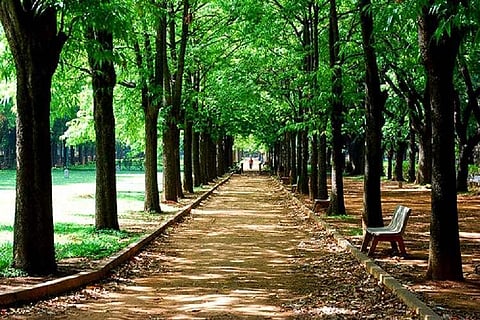

A 2017 study conducted by scientists at the Indian Institute of Science using satellite imagery, remote sensing data and multi-criteria decision-making techniques had predicted that Bengaluru, once known as the Garden City, will have a tree cover of only 2.96% by 2020. This, as opposed to 68.2% in 1973 and 38.7% in 2002.
But now, the situation might deteriorate further if the contentious 96 km long elevated corridor project criss-crossing the city sees the light of day.
In fact, not only will the loss be as high as 3009 trees but the project will also cut through a section of the city’s remaining untouched green cover, which had escaped concretisation. Another 601 trees will be pruned in addition, due to the project, according to the Environmental Impact Assessment report.
The study conducted by consultants Aecom, Deloitte and Infra Support, accessed by TNM, says that 858 trees in “sensitive wooded stretches” including Cubbon Park and Coles Park, will be sacrificed for the project.
| Cubban Park, Kasturabha Road | 120 |
| Near Bengaluru Palace, Jayamahal Road | 356 |
| Coles Park, Promenade Road | 47 |
| IISc Campus to Mekhri circle, CV Raman Road | 195 |
| IISc Campus to Yeshwanthpur circle, CV Raman Road | 32 |
| Raja ram Mohan Roy Road | 108 |
Despite stiff opposition from citizen activists, the Karnataka Road Development Corporation Limited had called for a hurried tender for the first phase of the project on the same day a conditional environmental clearance was issued by the State Environment Impact Assessment Authority. A mega protest like that against the steel bridge, consisting of a 8,000-strong human chain will be formed on Saturday by different citizen activist groups.
Even though the EIA has stipulated that every tree that is cut should be replaced with minimum 10 new trees as per the compensatory afforestation policy under Forest Conservation Act (1980), activists remain skeptical since no trees have been planted by any government authority in the city in the last two years.
Urban eco-conservationist Vijay Nishanth said, “The 3,000 trees figure seems very understated. During steel flyover project only, we saw that there were 2,000 trees in a 7km stretch when the government said there are 800 trees. This time also we will count the trees and in no way we will let this project continue. They cannot do this as there was no mandated meeting with the Tree Committee.”
Not only trees but lakes too
The EIA said that other than impacting the tree cover, the city’s already dwindling lakes will be further impacted due to this project. In fact, the proposed alignment will violate the National Green Tribunal ruling on buffer zone of lakes, rajakaluves on 10 counts.
| Lake | Distance in metre from lake boundary |
| Hebbal Lake | 5 |
| KR Puram Lake | 20 |
| Pond near Sarvagna Nagar | 20 |
| Ulsoor Lake | 5 |
| Varthur Lake | 5 |
| Vrishabhavathi Nalla | 5 |
| Agara Lake | 30 |
| Challkere | 30 |
| Banaswadi rajakaluve | 1 |
| Shantinagar Rajakaluve | 1 |
The report reads, “There are many water bodies along the proposed route of elevated corridors. Construction of the project corridor and the associated activities will impact the water bodies and its ecology. The debris generated from the demolition of structures and excavation for pile foundation could potentially find its way to the nearby water bodies adjacent to the project corridor. This will not only silt up the lakes but also impact the aquatic life in these water bodies.”
‘Illegality’
Senior advocate and member of Environment Support Group, Leo Saldanha said the entire project proceedings is a subterfuge of law.
“The project is illegal as it has not been formulated in accordance with the Town and Country Planning Act. The environmental clearance has been given under duress. Both the tender and EC given are invalid in law. This is a typical case of subterfuge of law. Both the government and regulatory authority have subverted the law. It is a case of corruption in decision making,” the senior lawyer told TNM.